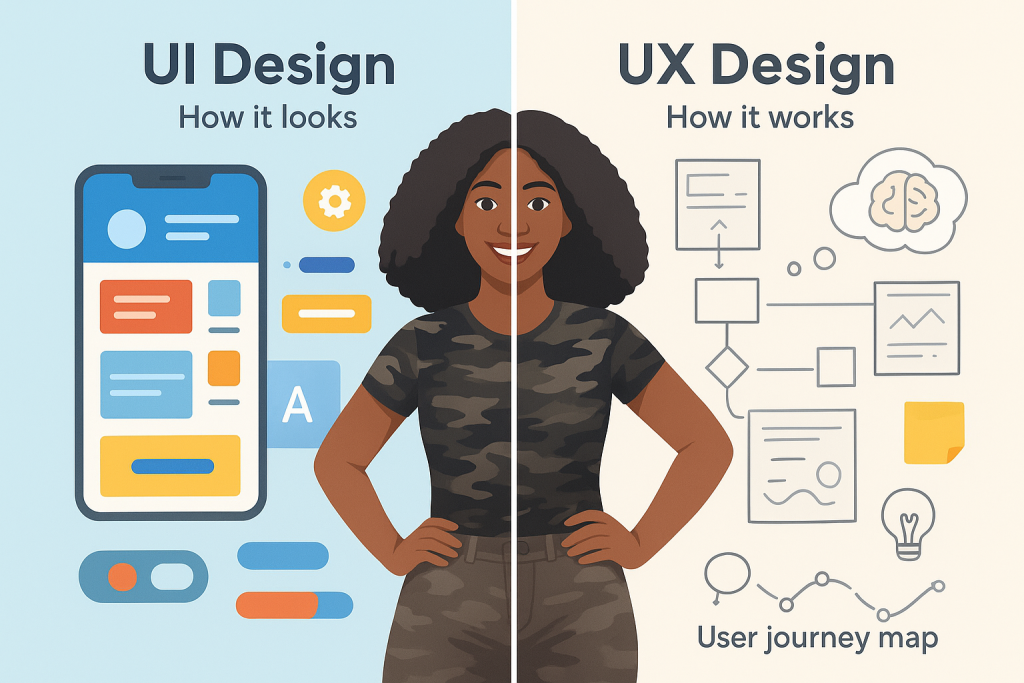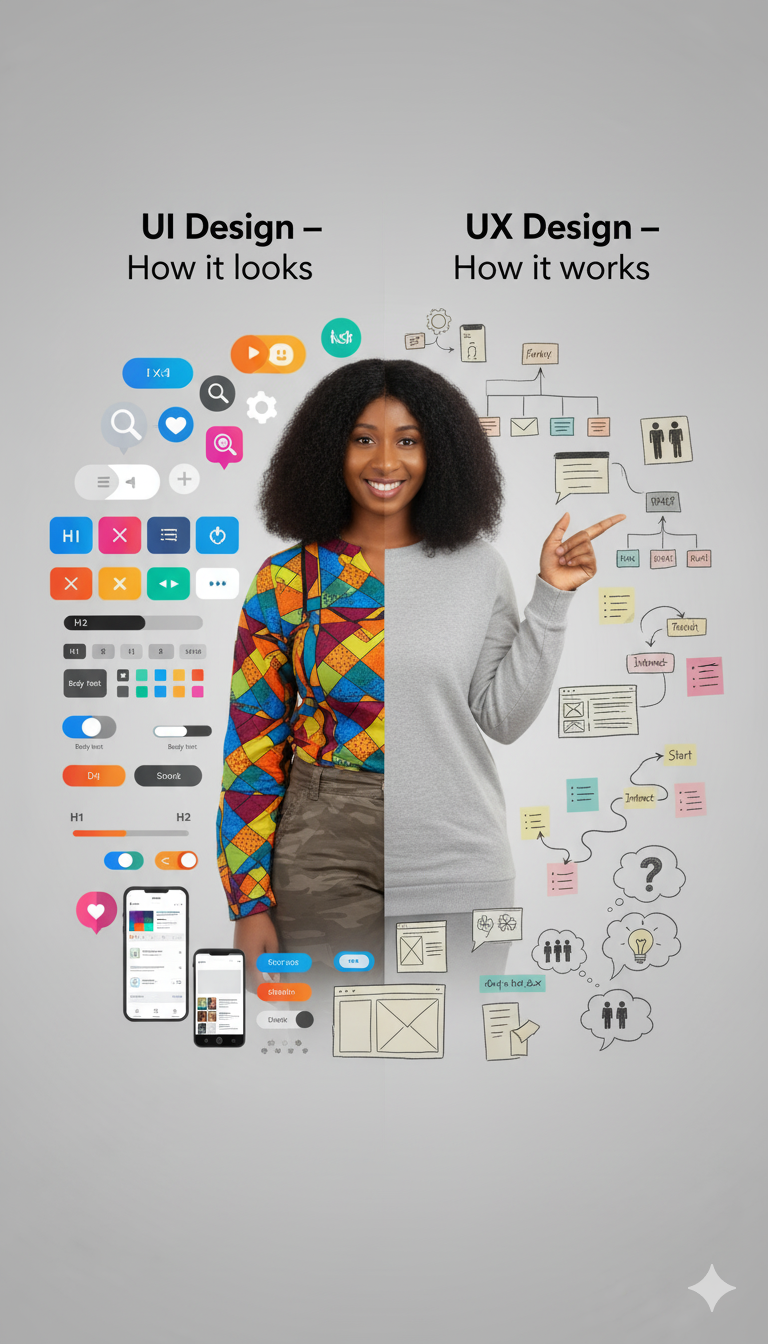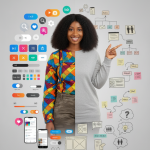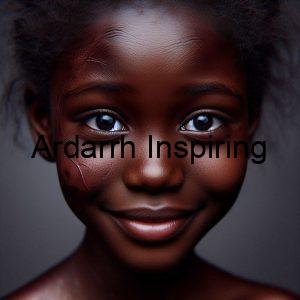When people hear the terms UI (User Interface) and UX (User Experience), they often assume they mean the same thing. But the truth is, they are like identical twins with different personalities — connected, inseparable, yet playing completely different roles in making a product work beautifully.
Think about it like this:
When you walk into a restaurant, the UI is what you see — the lighting, the colors, the table setup, the menu design.
The UX, however, is how you feel — how the waiter treats you, how long you wait for your food, and how satisfied you are when you leave.
That difference between “what you see” and “what you experience” is exactly what this illustration shows — me standing at the intersection of how it looks and how it works.
Understanding UI: The Look and Feel
User Interface (UI) is all about the look.
It’s the designer’s brush, where creativity meets digital structure. UI designers focus on how each visual element — buttons, colors, typography, icons, and layout — contributes to an attractive and intuitive interface.
In the illustration, the left side is filled with bright, interactive visuals: app screens, toggles, and typography. That’s the world of UI — making something visually appealing and accessible.
Let’s take an example.
Imagine you open a mobile banking app. The beautiful gradient background, the neat icons, and that soothing blue tone that makes you feel safe and professional — that’s UI. It sets the visual tone and first impression.
But here’s the twist: a good-looking app isn’t enough.
If the buttons don’t work smoothly or if users get confused about how to transfer money, that’s where UI stops and UX begins.
Understanding UX: The Experience That Follows
User Experience (UX), on the other hand, is about the feel.
It’s how easy, satisfying, and meaningful the product is for the user. A UX designer studies human behaviour, anticipates needs, and removes friction points from the user’s journey.
In the illustration, the right side is filled with wireframes, flowcharts, and user journey maps. This represents the behind-the-scenes thinking that shapes how someone interacts with a product.
Using the same banking app example:
If you can open the app, log in smoothly, find your balance easily, and send money within seconds — that’s UX magic.
UX ensures that every tap feels natural and purposeful.
Steve Jobs once said, “Design is not just what it looks like and feels like. Design is how it works.”
That’s UX in one sentence — invisible, yet powerful.
Why Both UI and UX Matter Together
One cannot truly shine without the other.
A beautiful interface (UI) without great usability (UX) frustrates users.
Meanwhile, a seamless experience (UX) without visual appeal (UI) feels uninspired.
Think of UI as makeup and UX as personality.
The makeup catches your attention, but the personality keeps you interested.
In real-world design, the two must collaborate closely.
When building a new website for a client, I’ve seen situations where the color scheme and fonts were perfect, yet users struggled to find the “contact” button. That’s a UI-UX imbalance.
It’s like having a gorgeous car exterior but no proper steering — looks good, drives poorly.
When UI and UX blend perfectly, they create emotional connections.
You don’t just use the product; you enjoy it.
The Designer’s Journey: Thinking Like a User
As a creative and digital specialist, I’ve learned that empathy is the secret ingredient in UX design.
You have to feel what the user feels — their confusion, excitement, frustration, and relief.
When I design interfaces or revamp a website, I often pause to ask:
“If I were visiting this page for the first time, what would I want to see?”
“Can I complete my goal without asking for help?”
“Does this flow make sense emotionally and logically?”
UI design may win the eyes, but UX design wins the heart.
That’s why companies like Apple, Airbnb, and Canva dominate their industries — they combine elegance (UI) with effortless usability (UX).
Airbnb, for example, doesn’t just show you houses.
It helps you feel at home before you even book.
That emotional response is a UX achievement built on clean UI.
A Quick Real-Life Example
Let’s say you visit two online clothing stores.
Store A has a visually stunning interface — bold images, trendy fonts, and animated banners. But it takes forever to load, and you can’t easily find your size.
Store B, however, looks simpler. The colors are calm, the filters are intuitive, and you check out smoothly.
Which one would you return to?
That’s the difference between UI and UX.
The first caught your eyes; the second earned your trust.
The Visual Breakdown: My Illustration
In the image above, I wanted to visually demonstrate this balance through design.
The left half — “UI Design: How it looks” — bursts with shapes, colors, and app layouts, symbolizing creativity and aesthetic appeal.
The right half — “UX Design: How it works” — uses flowcharts, journey maps, and logical elements to represent structure and thoughtfulness.
Standing in the middle, I represent every creative trying to balance both worlds — designing not just for beauty, but for purpose.
It’s a reminder that design is not only what we see but also what we feel when we interact with something.
The Big Takeaway
A product with strong UI gets you in the door.
A product with strong UX makes you stay.
If you’re a designer, marketer, or creative professional, start thinking in both directions:
When you choose colors and typography, think: How will this make the user feel?
When you design workflows and user journeys, think: How can I make this easier and more delightful?
It’s not about choosing one side — it’s about blending both art and empathy.

Closing Thoughts
Every click, swipe, and scroll tells a story.
UI shapes what we see, UX shapes how we experience it — and together they define how people remember us.
In a world where attention spans are shrinking and user expectations are rising, the best designs are not just beautiful — they are meaningful.
They speak visually (UI) and emotionally (UX).
And that’s the real power of design: to make people feel at home in a digital space.












